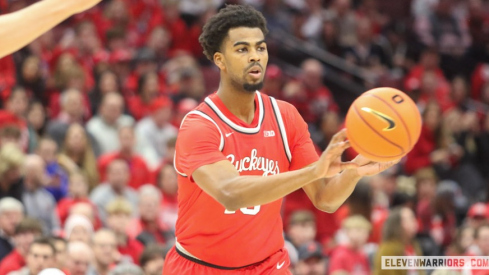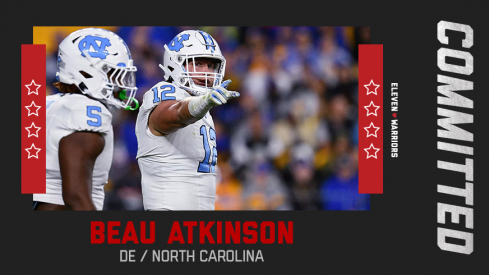Eli and Peyton Manning. The Gronkowski brothers. Bruce and Clay Matthews. Steph, Seth, and Dell Curry. The Williams sisters. The DiMaggio brothers.
These are just a handful of the abundant examples of extraordinarily athletic families, and Ohio State is about to add its own duo to that list.
The nation’s second-ranked defensive end, Nick Bosa has announced he will be an Ohio State Buckeye in 2016.
Joey Bosa has been a dominating force on the field at the collegiate level, so how will Nick measure up? Based on research of the genetics of athletic performance, we can look forward to some serious defensive power.
Performance-enhancing genetic variants have been discovered in elite athletes. Specific genes associated with pain tolerance, the contraction of fast-twitch muscles, blood flow to muscles, muscle structure, oxygen transport, and energy production can all contribute to athletic success.
Let’s go back to science class (briefly). The insertion or deletion of certain alleles (variants of genes) can determine different physical outcomes.
Fancy words. What’s it all mean?
Think of playing Madden. You can “create” your athlete on the game, right? You pick and choose ratings for strength, speed, agility, catching, and more. A similar phenomenon happens in our DNA.
First, consider pain tolerance. Don’t think of this as the ability to push through acute, sharp pain (like with an injury), but rather as the mental and physical fortitude to push through the discomfort of exertion; to dig deeper. Some athletes have it, some don’t. The ones who do are the ones who thrive at the collegiate level and beyond.
There are certain makeups of genes that can allow some people to tolerate pain better than others by altering the way they perceive the painful stimulus; in other words, some people feel the same exact stimulus less.
Contemplate the “1-10” pain scale frequently used in medicine. An identical stimulus might be perceived as a “6” by some and a “10” by others.
There is a certain level of discomfort that inherently comes with being a defensive end, and some people are better equipped to handle this discomfort solely from a genetic standpoint. Just look at Joey Bosa’s characteristic shrug every time he sacks a quarterback. He’s telling us exactly what I just described: It’s no big deal to him. Easy. Done. No problem. ¯\_(ツ)_/¯
In terms of muscle composition, there’s a trade-off between traits which are good for endurance and traits which are desirable for speed and power. The latter includes a higher ratio of “fast-twitch” to “slow-twitch” muscle fibers, and that ratio is advantageous, of course, in football players. The former would be ideal for a long-distance runner or swimmer.
Different variants of genes have also been associated with better cardiorespiratory function, meaning these athletes can do more work before becoming fatigued. This can be due to more optimal oxygen delivery to muscle tissues, for example.
When athletes feel exhausted and sore, they have reached a point in their workout when oxygen is not getting to the muscles as well as it normally would. The demand for oxygen is outweighing the supply. Oxygen is the nutrient which feeds muscle metabolism, but the muscles can’t just quit and die off when athletes push their limits.
So, what happens instead? Our bodies switch into “anaerobic metabolism,” which means metabolism which doesn’t use oxygen. Think of this like when your power goes out, but your alarm clock keeps running on its reserve battery power. In the body, this reserve power creates lactic acid, which makes us perceive soreness.
Athletes with genes to optimize oxygen delivery to the working musculature will be able to work longer and harder before they feel sore. This advantage can be observed in the fourth quarter and overtime of games. It’s where the greatest athletes rise above the rest.
Being a talented athlete runs in families. That’s clear. Being a member of the Bosa family is like having a cheat code for Madden. They’ve maxed out all the skill categories. It’s raw, natural, genetic talent. Couple that with the unmatched work ethic that both Joey and Nick have exhibited, and you have unstoppable on-field authority. Stay tuned for 2016. It’s going to be a fun show.
References:
- MacArthur, Daniel G., and Kathryn N. North. "Genes and human elite athletic performance." Human genetics 116.5 (2005): 331-339.
- Ostrander, Elaine A., Heather J. Huson, and Gary K. Ostrander. "Genetics of athletic performance." Annual review of genomics and human genetics 10 (2009): 407-429.
- Yang, Nan, et al. "ACTN3 genotype is associated with human elite athletic performance." The American Journal of Human Genetics 73.3 (2003): 627-631.
Special thanks to Dr. W. Lee Meyer of the OSU Wexner Medical Center for his input with the concept of this article and assistance with in-depth knowledge about Madden.


